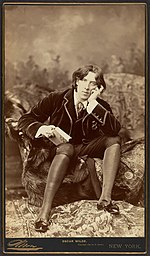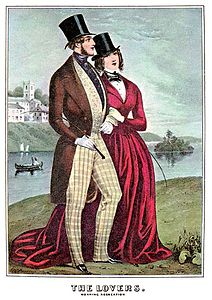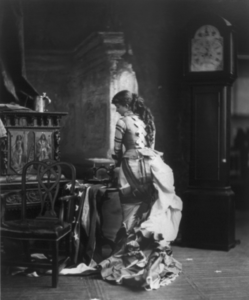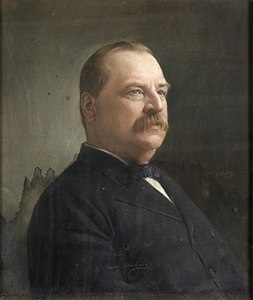| Napoléon Sarony | |
|---|---|
 Self-portrait, late 19th century Self-portrait, late 19th century | |
| Born | (1821-03-09)March 9, 1821 Quebec, Lower Canada |
| Died | November 9, 1896(1896-11-09) (aged 75) New York City, U.S. |
| Nationality | American |
| Known for | Photography |
Napoléon Sarony (March 9, 1821 – November 9, 1896) was an American lithographer and photographer. He was a highly popular portrait photographer, best known for his portraits of the stars of late-19th-century American theater. His son, Otto Sarony, continued the family business as a theater and film star photographer.
Life
Sarony was born in 1821 in Quebec, then in the British colony of Lower Canada, and moved to New York City around 1833. He worked as an illustrator for Currier and Ives before joining with James Major and starting his own lithography business, Sarony & Major, in 1843. In 1845, James Major was replaced in Sarony & Major by Henry B. Major, and the firm continued operating under that name until 1853. From 1853 to 1857, the firm was known as Sarony and Company, and from 1857 to 1867, as Sarony, Major & Knapp. Sarony left the firm in 1858 and traveled abroad for the next eight years. During that time, he learned the photographic portrait business from his brother Oliver Sarony who operated a popular portrait studio in Scarborough, England. Sarony established his own first portrait studio at 66 New Street in Birmingham, England around 1865. In June 1866, he returned to New York City. His first U.S. photographic studio was located at 680 Broadway. In 1876, he moved his operations to what became his more famous studio building at 37 Union Square. Photographers would pay their famous subjects to sit for them, and then retain full rights to sell the pictures. Sarony reportedly paid the internationally famous stage actress Sarah Bernhardt $1,500 to pose for his camera, equivalent to $50,867 in 2023. In 1894, he published a portfolio of prints entitled "Sarony's Living Pictures".
Associations
Included among the thousands of people that came into Sarony's world were many distinguished people, such as American Civil War General William T. Sherman and literary figures Samuel Clemens (Mark Twain), Lew Wallace and Oscar Wilde. Sarony also took a photograph of the great American inventor Nikola Tesla that was later engraved by T. Johnson.
William T. Sherman

In 1888, Sarony photographed William T. Sherman, three years before he died in 1891. Sarony's photograph would be used as a model for the engraving of the first Sherman Postage stamp.
Samuel Clemens; the Lotos, Salmagundi and Tile Clubs
Sarony took numerous photographs of Samuel Clemens (Mark Twain). Clemens and Sarony were in the same social circles and shared many acquaintances. They both belonged to the Lotos Club in New York City. Sarony helped in the founding of the Salmagundi Club, an association of artists, and was also a member of the Tile Club, whose members included well-known artists and journalists. In 1883, English author Wilkie Collins dedicated his anti-vivisection book Heart and Science to Sarony. In 1884, Sarony was a participant in an April Fool's joke played on Clemens when George Washington Cable arranged for 150 of Clemens's friends to write to him simultaneously, requesting his autograph. As part of the joke, no stamps or envelopes were to be provided for a reply.
Oscar Wilde

One of Sarony's portraits of writer Oscar Wilde became the subject of a U.S. Supreme Court case, Burrow-Giles Lithographic Co. v. Sarony 111 U.S. 53 (1884), in which the Court upheld the extension of copyright protection to photographs. Sarony sued Burrow-Giles after it used unauthorized lithographs of Oscar Wilde No. 18 in an advertisement, and won a judgment for $610 ($21,000 in modern dollars) that was affirmed on appeal by the Second Circuit Court of Appeals and the Supreme Court. Sarony later photographed the Supreme Court itself, to celebrate the centennial of the federal judiciary in 1890.
Family
Sarony was married twice. His first wife, Ellen Major Sarony, died in 1858; his second wife, Louisa "Louie" Long Thomas Sarony (1838-1903), reportedly shared his tendency towards eccentricity and preference for outlandish dress. She rented elaborate costumes that she wore during her daily afternoon walk through Washington Square, wearing them once before returning them.
His brother, Oliver François Xavier Sarony (1820–1879), was also a portrait photographer, working primarily in England, who died in 1879. Napoleon's son, Otto (1850–1903), continued the family name for a few years until his own death in 1903.
Sarony was buried in Green-Wood Cemetery in Brooklyn.
See also
Gallery
-
 Oscar Wilde
Oscar Wilde
-
 Joseph Jefferson as Rip Van Winkle, 1869
Joseph Jefferson as Rip Van Winkle, 1869
-
 Actress Sarah Bernhardt
Actress Sarah Bernhardt
-
 Sarah Bernhardt as Cleopatra, 1891
Sarah Bernhardt as Cleopatra, 1891
-
 Nikola Tesla
Nikola Tesla
-
 1850 print by Sarony and Major
1850 print by Sarony and Major
-
 Artist Thomas Moran, c. 1890–1896
Artist Thomas Moran, c. 1890–1896
-
 photo of James Huneker c. 1890
photo of James Huneker c. 1890
-
 "Sarony's Centennial Tableaux", showing young woman making U.S. Flag on sewing machine, c. 1876
"Sarony's Centennial Tableaux", showing young woman making U.S. Flag on sewing machine, c. 1876
-
 Grover Cleveland, 1882, Princeton University Art Museum
Grover Cleveland, 1882, Princeton University Art Museum
-
 Jasper Francis Cropsey, c. 1870
Jasper Francis Cropsey, c. 1870
References
- ^ Pauwels, Erin. "Napoleon Sarony's Living Pictures: The Celebrity Photograph in Gilded Age New York".
- "Napoleon Sarony". National Portrait Gallery, Smithsonian Institution. Retrieved January 16, 2015.
- ^ Schmidt, Barbara. "Mark Twain, Napoleon Sarony and 'The damned old libel'". twainquotes.com. Retrieved November 13, 2010.
- Scott US Stamp catalogue, identifier.
- 1634–1699: McCusker, J. J. (1997). How Much Is That in Real Money? A Historical Price Index for Use as a Deflator of Money Values in the Economy of the United States: Addenda et Corrigenda (PDF). American Antiquarian Society. 1700–1799: McCusker, J. J. (1992). How Much Is That in Real Money? A Historical Price Index for Use as a Deflator of Money Values in the Economy of the United States (PDF). American Antiquarian Society. 1800–present: Federal Reserve Bank of Minneapolis. "Consumer Price Index (estimate) 1800–". Retrieved February 29, 2024.
- "London Bound American Writers in England (1870 - 1916)". University of Delaware, library. Retrieved November 13, 2010.
- "Napoleon Sarony Dead". New York Times. November 10, 1896.
External links
- A Biographical Chronology for Napoleon Sarony
- Article and rare pictures of Napoleon Sarony and his subject Mark Twain
- Portrait of Oliver Sarony (1820-1879)
- The Sarony Photographs of Oscar Wilde (complete)